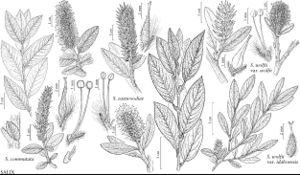Difference between revisions of "Salix wolfii var. wolfii"
FNA>Volume Importer |
FNA>Volume Importer |
(No difference)
| |
Revision as of 20:20, 24 September 2019
Plants 0.5–2 m. Stems: branches red-brown or violet, pubescent to glabrescent; branchlets yellow-brown or yellowish, sparsely pubescent or densely long-silky, hairs straight, wavy, curved, or crinkled. Leaves: petiole convex to flat, or shallowly grooved adaxially, 3–5.6 mm, pubescent or long-silky adaxially; largest medial blade narrowly oblong, narrowly elliptic, elliptic, or oblanceolate, apex acute, acuminate, or convex, abaxial surface pubescent, short-silky, or villous, adaxial sparsely to densely short- to long-silky, or villous; juvenile blade short- to long-silky or villous abaxially. Catkins: pistillate moderately or very densely flowered, subglobose or globose, 8.5–19 × 7–12 mm, flowering branchlet 1–7 mm; floral bract 0.8–1.6 mm. Staminate flowers: abaxial nectary (0–)0.1–0.2 mm, adaxial nectary 0.4–0.5 mm. Pistillate flowers: adaxial nectary oblong, 0.4–0.8 mm, shorter to longer than stipe; stipe 0.2–0.9 mm; ovary glabrous; ovules 10–12 per ovary; stigmas flat, abaxially non-papillate with rounded or pointed tip. 2n = 38.
Phenology: Flowering early-mid Jun.
Habitat: Stream banks, springs, wet meadows, bogs
Elevation: 2000-3800 m
Distribution

Colo., Idaho, Mont., Nev., Oreg., Utah, Wyo.
Discussion
Hybrids:
Variety wolfii forms natural hybrids with Salix boothii.
Selected References
None.
